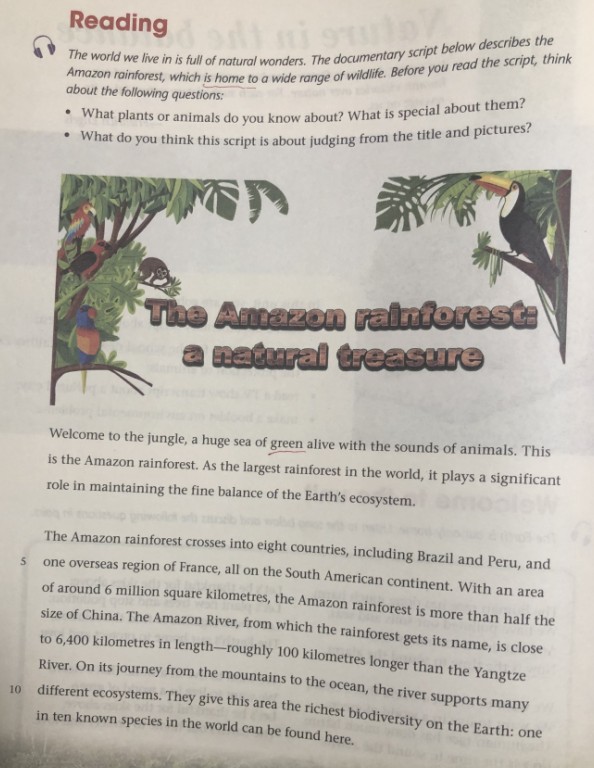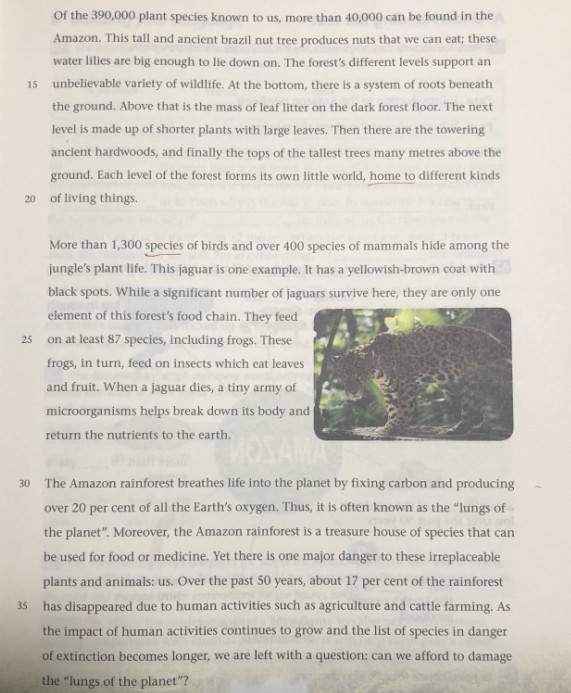5 求译林版高中英语必修三第1单元Reading的word文档
最佳答案 2022-11-01 00:13
- Welcome to the jungle, a huge sea of green alive with the sounds of animals. This is the Amazon rainforest. As the largest rainforest in the world, it plays a significant role in maintaining the fine balance of the Earth's ecosystem.
- The Amazon rainforest crosses into eight countries, including Brazil and Peru, and one overseas region of France, all on the South American continent. With an area of around 6 million square kilometers, the Amazon rainforest is more than half the size of China. The Amazon River, from which the rainforest gets its name, is close to 6,400 kilometers in length — roughly 100 kilometers longer than the Yangtze River. On its journey from the mountains to the ocean, the river supports many different ecosystems. They give this area the richest biodiversity on the Earth: one in ten known species in the world can be found here.
- Of the 390,000 plant species known to us, more than 40,000 can be found in the Amazon. This tall and ancient Brazil nut tree produces nuts that we can eat; these water lilies are big enough to lie down on. The forest's different levels support an unbelievable variety of wildlife. At the bottom, there is a system of roots beneath the ground. Above that is the mass of leaf litter on the dark forest floor. The next level is made up of shorter plants with large leaves. Then there are the towering ancient hardwoods, and finally the tops of the tallest trees many meters above the ground. Each level of the forest forms its own little world, home to different kinds of living things.
- More than 1,300 species of birds and over 400 species of mammals hide among the jungle's plant life. This jaguar is one example. It has a yellowish-brown coat with black spots. While a significant number of jaguars survive here, they are only one element of this forest's food chain. They feed on at least 87 species, including frogs. These frogs, in turn, feed on insects which eat leaves and fruit. When a jaguar dies, a tiny army of microorganisms helps break down its body and return the nutrients to the earth.
- The Amazon rainforest breathes life into the planet by fixing carbon and producing over 20 per cent of all the Earth's oxygen. Thus, it is often known as the “lungs of the planet”. Moreover, the Amazon rainforest is a treasure house of species that can be used for food or medicine. Yet there is one major danger to these irreplaceable plants and animals: us. Over the past 50 years, about 17 per cent of the rainforest has disappeared due to human activities such as agriculture and cattle farming. As the impact of human activities continues to grow and the list of species in danger of extinction becomes longer, we are left with a question: can we afford to damage the “lungs of the planet”?
请先 登录 后评论
- 1 关注
- 0 收藏,2236 浏览
- small 提出于 2022-02-15 22:37
相似问题
-
 《高考英语备考1号·速效编》
《高考英语备考1号·速效编》
-
 《高考英语备考1号·写作编》
《高考英语备考1号·写作编》
-
 《高中英语晨读晚记》
《高中英语晨读晚记》
-
 《高中英语错题笔记》
《高中英语错题笔记》
-
 《零起点考大学英语》
《零起点考大学英语》
-


